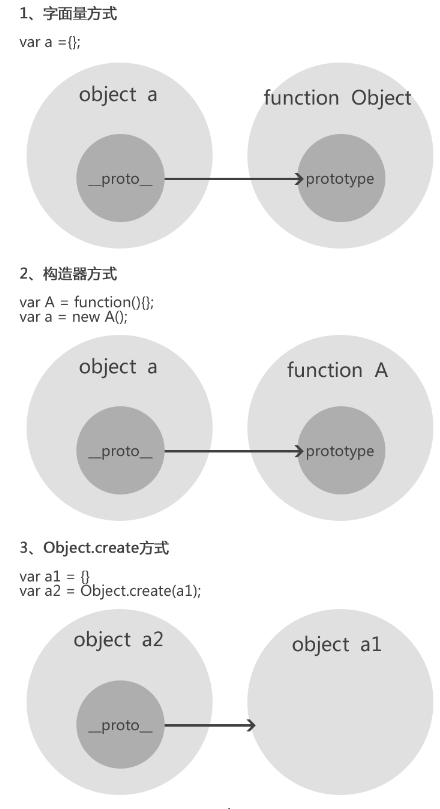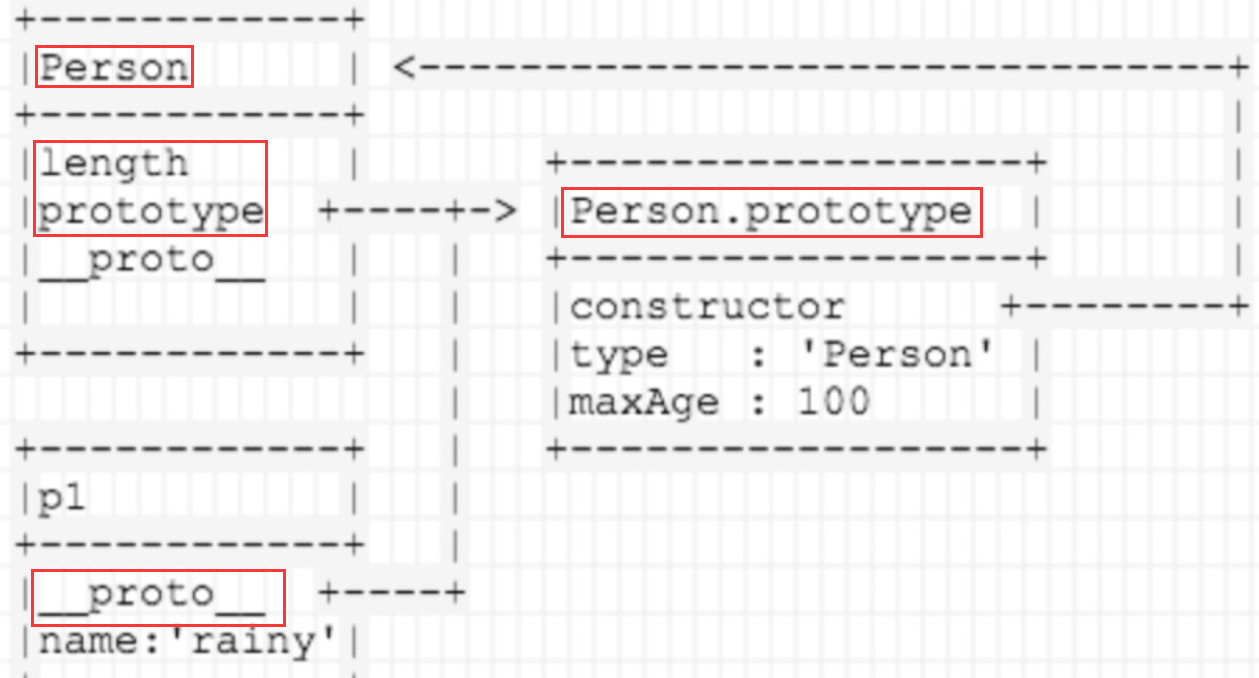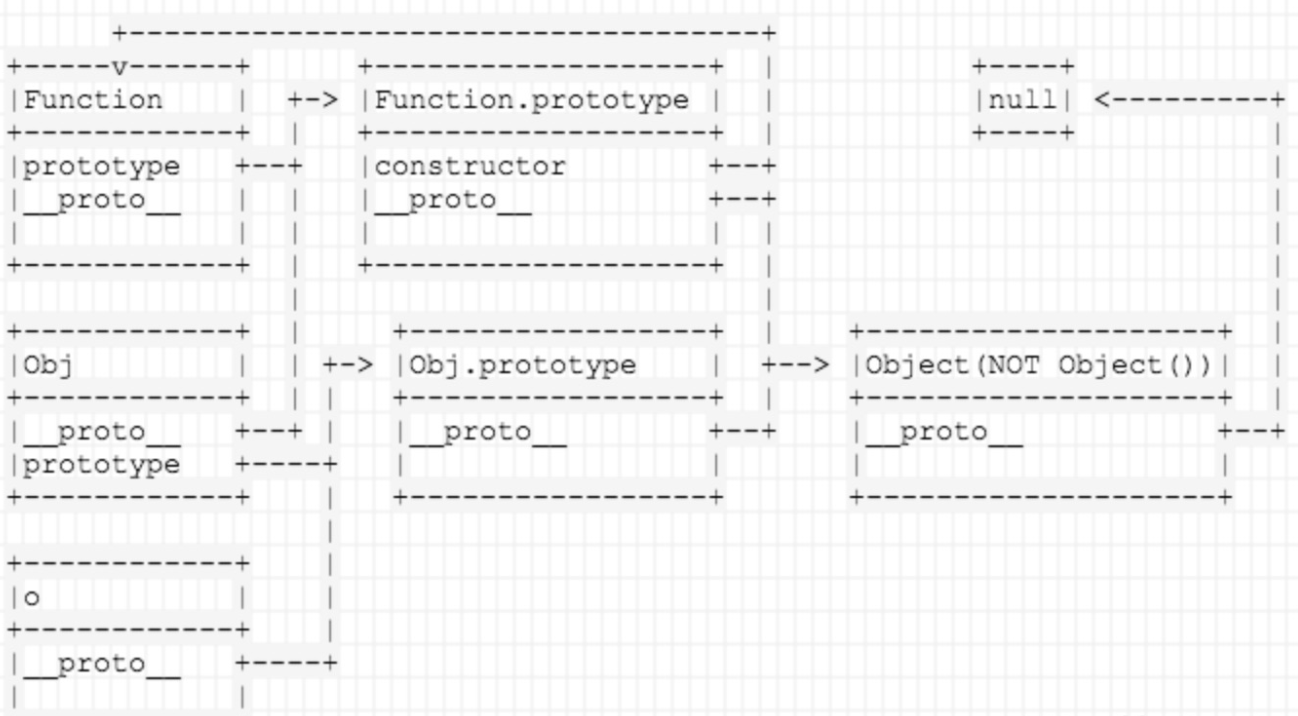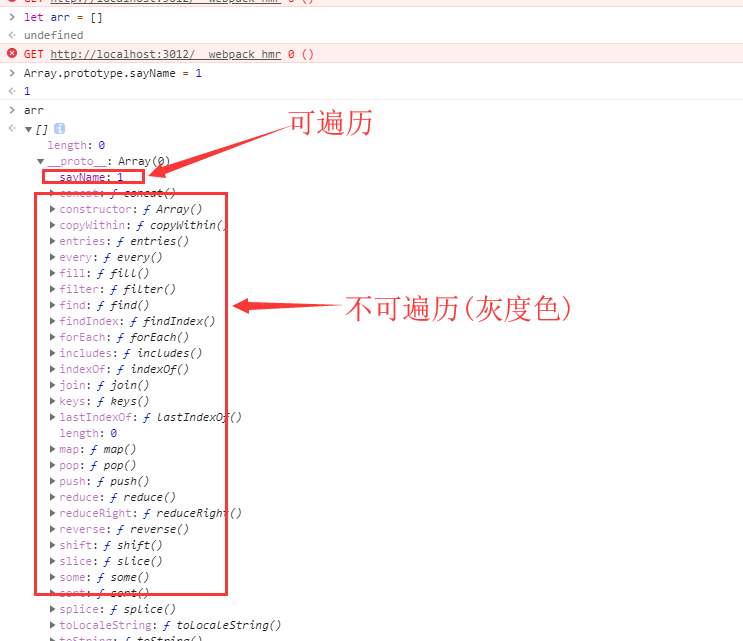js 原型链 prototype __proto__
1、说明
函数(Function)才有prototype属性,对象(除Object)拥有__proto__。
2、prototype与__proto__区别


示例:
<!DOCTYPE html>
<html lang="zh">
<head>
<meta charset="UTF-8" />
<meta name="viewport" content="width=device-width, initial-scale=1.0" />
<meta http-equiv="X-UA-Compatible" content="ie=edge" />
<title>prototype与__proto__区别</title>
</head>
<body>
<script src="https://cdn.bootcss.com/lodash.js/4.17.10/lodash.min.js"></script>
<script type="text/javascript">
var a = {};
console.log(a.prototype); //undefined
console.log(a.__proto__); //Object {}
var b = function() {}
console.log(b.prototype); //b {}
console.log(b.__proto__); //function() {}
</script>
</body>
</html>
控制台输出:

(3)__proto__指向

示例:
<!DOCTYPE html>
<html lang="zh">
<head>
<meta charset="UTF-8" />
<meta name="viewport" content="width=device-width, initial-scale=1.0" />
<meta http-equiv="X-UA-Compatible" content="ie=edge" />
<title>__proto__指向</title>
</head>
<body>
<script src="https://cdn.bootcss.com/lodash.js/4.17.10/lodash.min.js"></script>
<script type="text/javascript">
/*1、字面量方式*/
var a = {};
console.log(a.__proto__); //Object {}
console.log(a.__proto__ === a.constructor.prototype); //true
/*2、构造器方式*/
var A = function() {};
var b = new A();
console.log(b.__proto__); //A {}
console.log(b.__proto__ === b.constructor.prototype); //true
/*3、Object.create()方式*/
var a1 = {
a: 1
}
var a2 = Object.create(a1);
console.log(a2.__proto__); //Object {a: 1}
console.log(a2.__proto__ === a2.constructor.prototype); //false(此处即为图1中的例外情况)
</script>
</body>
</html>
控制台输出:

(4)原型链
(1)是__proto__指向的一条指针链!
(2)查找属性时,首先先查找自身属性,找不到的话,在查找原型链上的属性。但是不会查找自身的prototype属性。
示例代码:
<!DOCTYPE html>
<html lang="zh">
<head>
<meta charset="UTF-8" />
<meta name="viewport" content="width=device-width, initial-scale=1.0" />
<meta http-equiv="X-UA-Compatible" content="ie=edge" />
<title>属性查找</title>
</head>
<body>
<script src="https://cdn.bootcss.com/lodash.js/4.17.10/lodash.min.js"></script>
<script type="text/javascript">
Function.prototype.age = 20;
let b = function() {}
b.prototype.age = 10;
console.log(b.age)//输出20
</script>
</body>
</html>

示例:
<!DOCTYPE html>
<html lang="zh">
<head>
<meta charset="UTF-8" />
<meta name="viewport" content="width=device-width, initial-scale=1.0" />
<meta http-equiv="X-UA-Compatible" content="ie=edge" />
<title>原型链</title>
</head>
<body>
<script src="https://cdn.bootcss.com/lodash.js/4.17.10/lodash.min.js"></script>
<script type="text/javascript">
var A = function() {};
var a = new A();
console.log(a.__proto__); //A {}(即构造器function A 的原型对象)
console.log(a.__proto__.__proto__); //Object {}(即构造器function Object 的原型对象)
console.log(a.__proto__.__proto__.__proto__); //null
</script>
</body>
</html>
(5)prototype
prototype和length是每一个函数类型自带的两个属性,而其它非函数类型并没有,这一点之所以比较容易被忽略或误解,是因为所有类型的构造函数本身也是函数,所以它们自带了prototype属性:
示例:
<!DOCTYPE html>
<html lang="zh">
<head>
<meta charset="UTF-8" />
<meta name="viewport" content="width=device-width, initial-scale=1.0" />
<meta http-equiv="X-UA-Compatible" content="ie=edge" />
<title>prototype</title>
</head>
<body>
<script src="https://cdn.bootcss.com/lodash.js/4.17.10/lodash.min.js"></script>
<script type="text/javascript">
console.log(Object.prototype); //=> {}
console.log(Function.prototype); //=> [Function: Empty]
console.log(String.prototype); //=> [String: '']
</script>
</body>
</html>
除了prototype之外,Js中的所有对象(undefined、null等特殊情况除外)都有一个内置的[[Prototype]]属性,指向它“父类”的prototype,这个内置属性在ECMA标准中并没有给出明确的获取方式,但是许多Js的实现(如Node、大部分浏览器等)都提供了一个__proto__属性来指代这一[[Prototype]],我们通过下面的例子来说明实例中的__proto__是如何指向构造函数的prototype的:
<!DOCTYPE html>
<html lang="zh">
<head>
<meta charset="UTF-8" />
<meta name="viewport" content="width=device-width, initial-scale=1.0" />
<meta http-equiv="X-UA-Compatible" content="ie=edge" />
<title>prototype与__proto__</title>
</head>
<body>
<script src="https://cdn.bootcss.com/lodash.js/4.17.10/lodash.min.js"></script>
<script type="text/javascript">
var Person = function() {};
Person.prototype.type = 'Person';
Person.prototype.maxAge = 100;
var p = new Person();
p.name = 'rainy';
Person.prototype.constructor === Person; //=> true
p.__proto__ === Person.prototype; //=> true
console.log(p.prototype); //=> undefined
console.log(p.maxAge); //100
console.log(p.__proto__.maxAge); //100
console.log(p.name); //rainy
console.log(p.__proto__.name); //undefined
</script>
</body>
</html>
图示:

Person是一个函数类型的变量,因此自带了prototype属性,prototype指向中的Person.prototype对象。Person.prototype.constructor又指向Person本身;通过new关键字生成的Person类的实例p1,通过__proto__属性指向了Person的原型。这里的__proto__只是为了说明实例p1在内部实现的时候与父类之间存在的关联(指向父类的原型),在实际操作过程中实例可以直接通过.获取父类原型中的属性,从而实现了继承的功能。
(6)原型链
示例代码:
<!DOCTYPE html>
<html lang="zh">
<head>
<meta charset="UTF-8" />
<meta name="viewport" content="width=device-width, initial-scale=1.0" />
<meta http-equiv="X-UA-Compatible" content="ie=edge" />
<title>prototype与__proto__</title>
</head>
<body>
<script src="https://cdn.bootcss.com/lodash.js/4.17.10/lodash.min.js"></script>
<script type="text/javascript">
var Obj = function() {};
var o = new Obj();
o.__proto__ === Obj.prototype; //=> true
o.__proto__.constructor === Obj; //=> true
Obj.__proto__ === Function.prototype; //=> true
Obj.__proto__.constructor === Function; //=> true
Function.__proto__ === Function.prototype; //=> true
Object.__proto__ === Object.prototype; //=> false
Object.__proto__ === Function.prototype; //=> true
Function.__proto__.constructor === Function; //=> true
Function.__proto__.__proto__; //=> {}
Function.__proto__.__proto__ === o.__proto__.__proto__; //=> true
o.__proto__.__proto__.__proto__ === null; //=> true
</script>
</body>
</html>
(7)null与undefined
null与undefined 无原型
//报错
console.log(Object.getPrototypeOf(undefined))
//报错
console.log(Object.getPrototypeOf(null))

从上面的例子和图解可以看出,prototype对象也有__proto__属性,向上追溯一直到null。
(8)原型链的遍历过程(一直到null)
<!DOCTYPE html>
<html lang="zh">
<head>
<meta charset="UTF-8" />
<meta name="viewport" content="width=device-width, initial-scale=1.0" />
<meta http-equiv="X-UA-Compatible" content="ie=edge" />
<title>原型链的遍历过程</title>
</head>
<body>
<script src="https://cdn.bootcss.com/lodash.js/4.17.10/lodash.min.js"></script>
<script type="text/javascript">
let a = 1
console.log(a.__proto__ === Number.prototype) //true
console.log(Number.__proto__ === Function.prototype) //true
console.log(Function.__proto__ === Function.prototype) //true
console.log(Function.__proto__.__proto__ === Object.prototype) //true
console.log(Function.__proto__.__proto__.__proto__)
</script>
</body>
</html>
(9)获取原型对象
Object.getPrototypeOf(object)
(10)原型上可遍历的属性

__proto__ 隐式原型 prototype显示原型

作者:孟繁贵 Email:meng010387@126.com 期待共同进步!


 浙公网安备 33010602011771号
浙公网安备 33010602011771号